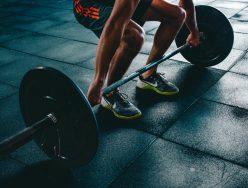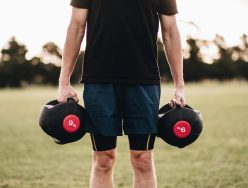The push-up is iconic. It remains a symbol of strength and a constant staple in most workout routines today. Yet, many fitness professionals aren’t sure how to properly progress the push-up. For example, many of them have used the bosu, stability ball, dumbbells, an incline bench, and other tools to create challenging push-up exercises for their clients. While these pieces of equipment can surely pose as an experiment for your clients — there’s a more efficient method to push-up progression that doesn’t even need usage of any apparatus.
Most clients can benefit from properly progressing their push-up because appropriate push-up progression provides: core stabilization, improved posture, increased power, extra endurance, stronger stability in your joints, more strength in their upper and lower body, increased muscle mass, and fat loss.
Mastering push-ups in terms of Stabilization, then Strength, to then graduate to Power is fundamental in achieving optimal core stabilization and movement muscles while building lean muscle by engaging the correct muscles. These phases cannot be skipped and shouldn’t be progressed until each phase is truly mastered especially while using any equipment. In other words, a client should first progress accordingly using their own body weight before the usage of a bosu or other supporting apparatus.
Stabilization exercises are the start of your clients’ push-up journey and the “building blocks” to any proper strength and eventual power program. Stabilization push-up exercises incorporate the core stabilization muscles and some of your clients’ core movement muscles as they advance to more challenging push-ups. Additionally, stabilization push-ups help create strength to progress your clients into the next strength push-up, they can provide stability to weak muscles, preventing potential muscular compensations and even possible injuries.
When your clients have mastered efficient Stabilization, their strength progressions can flourish. Strength push-up exercises engage more of the core movement muscles than the core stabilization muscles because your clients are in motion. Strength movements provide a double functional and aesthetic hit to their core since they engage both groups of core muscles. Push-ups in the Strength phase can obviously promote strength, however, your clients will obtain hypertrophy, too.
Following your successfully completed phases of Stabilization and Strength, your clients’ final journey is the Power phase. Power can be defined as having optimal strength and quickness to perform a movement. When your clients have efficient stabilization and strength levels, power progressions are able to flourish due to the force needed to perform these power movements. Power push-up exercises engage more of their core movement muscles than their core stabilization muscles because they are constantly in motion.
Your clients may find that they are progressing steadily in certain push-up exercises and more slowly in others. Similarly, you may find that your clients may need more time to fully complete one push-up phase before moving onto the next. There’s definitely no shame in either scenario; remember that these push-ups are, in fact, a journey and that just as with any fitness program, their progress is their path. Also, remember that exercising is as much mental as it is physical. Please feel free to reiterate this to your clients to remind them to believe in themselves and their physical abilities. For that reason, before attempting any push-up on their fitness journey, have them say these words to themselves repeatedly and commit them to your memory, “I know I can do this push-up.” Positive thoughts are their fuel to succeed even when they feel physically fatigued or doubtful. Moreover, these positive thoughts build mental toughness to not only prosper with each individual push-up but every activity they personally perform in life.
Also, remember that exercising is as much mental as it is physical. Please feel free to reiterate this to your clients to remind them to believe in themselves and their physical abilities. For that reason, before attempting any push-up on their fitness journey, have them say these words to themselves repeatedly and commit them to your memory, “I know I can do this push-up.” Positive thoughts are their fuel to succeed even when they feel physically fatigued or doubtful. Moreover, these positive thoughts build mental toughness to not only prosper with each individual push-up but every activity they personally perform in life.
An example of a type of push-up for each phase is detailed below.
The Stabilization Phase
Isometric Push-ups

The first push-up on your clients’ push-up journey is an excellent isometric exercise to strengthen the core stabilization muscles and gluteus maximus muscles. The isometric hold will also create lean muscle in the anterior and medial deltoids (front and side shoulders), pectoralis major and minor muscles (chest muscles), and triceps. The back muscles, such as your scapulae (shoulder blades) also assist in stabilization to perform the push-up. Moreover, this push-up assists in developing stronger tendons in the rotator cuff.
Starting Position: Begin on the floor, assuming the traditional push-up position with the chest facing downward, legs extended, knees and feet together. The heels are positioned off the floor and positioned slightly forward. Position the hands slightly more than shoulder-width apart with the elbows only slightly bent.
To Perform: Hold this position with the elbows only slightly bent, legs extended, and the knees and feet together. The heels should still be off the floor and positioned slightly forward. There is no need to lower your upper body downward to the floor at this time since the main goal of this exercise is to achieve more core and upper body stability.
Beginner: Three sets, holding for 10 seconds each
Intermediate: Four sets, holding for 30 seconds each
Advanced: Four sets, holding for 60 seconds each
Rest time between sets should be 30 seconds to one minute for recovery.
Tips: If holding this pose is too difficult, then assume the starting position with the legs and feet out wider than shoulder-width apart. This new pose will make it easier for your clients’ body to stabilize the hold. However, before moving onto the next push-up, be sure that they can execute this push-up with their knees, legs, and feet together first. Their palms are naturally stable and can provide the proper stability needed to perform this exercise. Therefore, they may use your palms for added stability while performing this push-up, and in doing so alleviate any unwanted strain off of the wrists.
The Strength Phase
Staggered Push-ups

This is an advanced exercise since it incorporates more core, shoulder, and triceps stability than the Traditional Push-up, and therefore incorporates more strength in the rotator cuffs. This push-up builds lean muscle in the primary movers of this exercise which are the: anterior and medial deltoid muscles, pectoralis major and pectoralis minor muscles, triceps, and gluteus maximus muscle. Moreover, the “staggered” position of your hands will help in creating more overall strength when performing other push-ups that otherwise start with the hands shoulder-width apart.
Starting Position: Begin with the arms in a traditional push-up position, but then stagger the hands by moving one upwards about six inches (away from the shoulder), and the other downwards (towards the waist) about six inches, keeping them shoulder-width apart. The legs are locked, knees and feet are together with the heels up and all body weight forward on the hands, all of which create a more challenging core workout.
To Perform: Once they rise up from one push-up, have them continue to execute the next repetition while keeping their core in the neutral spinal position. The optimal goal is to have their nose gently touch the floor with every repetition. The elbow that is forward should be bent at 45-degrees while your rear elbow is bent at 20-degrees.
Beginners: Four sets total, two sets each side of 10 repetitions
Intermediate: Six sets total, three sets each side of 16 repetitions
Advanced: Six sets total, three sets each side of 24 repetitions.
Rest time between sets should be two to three minutes for recovery.
Tips: Particularly while performing this push-up, it’s vital to have your client maintain the neutral spinal position for engaging optimal core movement muscles. If they happen to lean with their hips or hike their hips up, this core positioning would not engage the correct core muscles. Be mindful that they not dip their shoulder or elevate their upper trapezius for strength. If the starting position proves to be too challenging, they may bring their hands in (closer towards the shoulders) for added stability. However, when that position proves comfortable or easy, challenge your client by having them bring their hands out to a true six inches apart before moving forward with their push-up journey. Do not let them flare their elbows outward more than 90-degrees while performing this push-up.
The Power Phase
Alternating Leg Push-ups

This exercise is a power movement that will involve more of your clients’ lower body since they will begin to implement jumping movements while building stronger core movement muscles and stabilization muscles in the process. This push-up builds lean muscle in the primary movers of this exercise, which are the anterior and medial deltoid muscles, pectoralis major and pectoralis minor muscles, triceps, gluteus maximus muscle, quadriceps, hamstrings, and calves. Your latissimus dorsi and scapulae are still helping stabilize during this exercise. Since this is a power movement, practically every muscle below their pelvis will be stretched during this exercise due to the height of their lower body.
Starting Position: Begin by having your client get into the push-up position with their hands positioned slightly wider than shoulder-width apart. They will have one leg up extended (locked) at the knee about two inches from the floor with their other foot on the floor.
To Perform: With one leg up about two inches above the floor, have your client lower their body downward, executing a push-up with their elbows bent at a 45-degree angle. The leg that is in the air is locked (extended) at the knee to recruit more muscle fibers in their gluteal muscles and hamstring. Before they begin the next repetition, have your client alternate legs by raising the other leg two inches above the floor, with a hop to the motion as they switch legs. This “hop” will provide the power needed for this exercise. Do not bring the raised leg higher than two inches above the floor because bringing their legs too high could cause unwanted strain and possible injury to their lower back muscles. The optimal goal is to have their nose gently touch the floor with each push-up for optimal range of motion while keeping constant form in their lower body. To clarify, one repetition equals one push-up with one leg up.
Beginner: Three sets, 10 repetitions (five with each leg)
Intermediate: Four sets, 12 repetitions (six with each leg)
Advanced: Four sets, 20 repetitions (10 with each leg)
Rest time between sets should be two to four minutes for recovery.
Tips: As stated above, be vigilant to not let your client raise the raised leg more than a few inches from the floor. Raising it too high can jeopardize the crucial neutral spinal position needed in this exercise for optimal engagement of the core movement and core stabilization muscles. Do your best to have your client maintain the power needed for proper execution of this movement by starting the “hopping” motion as they rise up from the push-up. Remember as always not to let them lean or hike their hips upwards while performing this powerful movement. As with the previous push-up, they should not flare their elbows outward more than 90-degrees. Lastly, do not let them drop their shoulder or elevate their upper trapezius. Have them engage their gluteus maximus muscles, “draw in” their abdominals for strength and remember to perform correct breathing.
For more information on progressing the push-up for your clientele, please check out: www.zetlinfitness.com to learn about Shaun’s “Push-up Progression” book series and his CEU courses with NASM and ISSA.
Was this Article Helpful?
If this article was helpful to you, please consider linking this article to your own blog or sharing this through the social buttons below. You will also find other great articles at “Ask An Expert“.
- 1share
- 0Facebook
- 1Twitter
- 0Pinterest
- 0LinkedIn
Shaun Zetlin
For over ten years, Shaun has successfully run his own personal training business in the New York City Metro area. Able to relate and adapt to each individual, Shaun prides himself on developing exercise plans and nutritional menus to foster every client's fitness needs. His clientele ranges from the athlete, and senior citizen, to bodybuilder, and dancer. Shaun's specialties include: strength training, power techniques, corrective injury training, and core stability training.
In addition to the highly regarded Master Trainer status, Shaun is a certified personal trainer of the National Academy of Sports Medicine (NASM). With NASM Shaun also holds specialized certifications in: Pre- and Post-Natal, Corrective Exercise Practices, Cardiovascular Weight Loss, Youth Training, Senior Citizen Training, Balance Training, Core Stabilization, and Self Myofascial Release (SMR). Additionally, Shaun is certified by the International Sports Sciences Association (ISSA) as a Strength and Conditioning Specialist and Sports Performance Nutrition Specialist, with training in the Female Athlete, Knee & Shoulder Rehabilitation, and Marathon Training. Shaun earned his Bachelors degree in English Literature and Writing from the University of Delaware.
Shaun's first full-length book, "Push-up Progression Workout for a Stronger Core" is currently available worldwide both in paperback and e-book formats. It was featured as one of three top books in 2013 for healthy living as selected by Dr. John Whyte of The Discovery Channel. His latest book, "Push-up Progression (2nd Edition)" has already achieved great success and notoriety in the world of fitness. It is currently featured in bookstores across the United States and United Kingdom in paperback and available wherever e-books are sold. Shaun has had a multitude of articles, program designs, and tips published within a variety of books, magazines, and on websites in the world of fitness and beyond including: Price World Publishing, Demos Medical Publishing, Livestrong, Rodale Books, OnFitness Magazine, Fitness Magazine, Brides Magazine, and GO: AirTran Magazine. Additionally, Fitness Professional Online recognizes Shaun as an "expert," answering questions for other fitness and health professionals.
Shaun also has media experience in both television and radio, ranging from fitness modeling, to hosting his own weekly radio fitness show.
Latest posts by Shaun Zetlin
- The Role of Exercise in Stress Management - May 9, 2017
- X-Push Up - December 27, 2016
- Fit Pros, How To Properly Progress Your Client’s Push-Up? - October 26, 2016


















